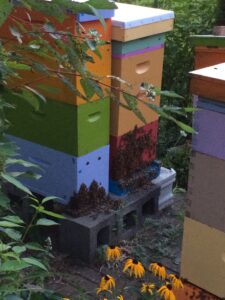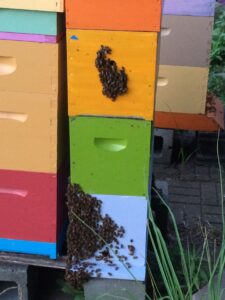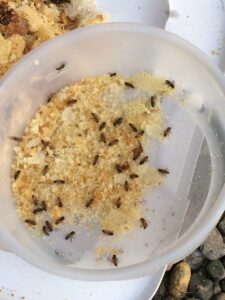Here are some things to consider for your apiary this time of year, if you live in a climate similar to SW Michigan …
Watch out for the Small Hive Beetles: Argh. We’ve got way more than we’d like to find in a half dozen of our hives. In one hive, that’s understandable; they’re definitely weak. We reduced their space by about 50%, allowing the bees to focus on chasing down these dang beetles. The other hive seems very strong. It yielded eight spectacular frames of honey, so I’m confused why they’re not keeping them under control, and there are lots of bees on all frames, so I’m uncomfortable removing a hive body.

Small hive beetles … and they’re really not that small. Seeing this many on practically every frame is a message that the bees could use some help dealing with them.

If allowed to flourish, the SHB will overwhelm a hive and ruin everything. (Google ‘small hive beetle.’)
If you see more than a few dozen, add beetle traps, and definitely reduce the space so the bee population can get the beetle population under control. It has been a fairly wet year, with minimal sun. Dry damp conditions seemed to diminish SHB success.
It is IMMENSELY rewarding to squish SHBs with your hive tool, although I’m not sure how effective it is.
Enjoy the bearding: This is one of my favorite beekeeping events, occurring often this time of year, especially on balmy evenings. The hive is full of nectar needing to be dried down for honey, and ba-bees, and worker bees. The foragers return late afternoon and don’t want to go in there and add to the heat, so they perch on the “porch” and enjoy the day. There’s another theory that says they’re lining up to vent air through the hive to help cure the nectar into honey as well. You’ll see them standing atop each other, often thick and sort of “massaging” the hive exterior. Generally you can get quite close and observe this fascinating bee-havior.
Make sure you have enough space: We still have goldenrod to come (a great source for bees to fill up the cupboards) and purple loosestrife. (Lots of people hate this invasive species, but we beekeepers are happy to see it.) A colony’s population is declining this time of year, and space that was being used for raising ba-bees is now being used for honey storage. Unless we have sunshiny days and occasional rain, we probably won’t have a huge nectar flow, but nonetheless make sure there’s room for them to store nectar and pollen from the fall floral sources. But of course, not too much space! (See above on SHB.)
Kiss the drones good-bye: And you can really kiss the drones—they don’t sting. (I don’t recommend kissing female bees—they have stingers.) The queen is laying very few, if any drones this time of year, and we all ready have some hives with NO drones. Their dear sisters kick them out come fall—who needs the hungry pigs eating stores and leaving their dirty socks on the floor? 🙂
Other undesirable parasites: Small hive beetles may be the least of your problems. The Varroa mite is relentless and formidable and if you have more than a few when you test, that hive is on a slow and painful march toward death. So … Test for mites. Figure out your levels, and if you have any (and almost every hive has some) figure out your treatment options based on the levels and what your management approach is. Not sure how to test? There’s an excellent resource here: http://honeybeehealthcoalition.org/wp-content/uploads/2015/08/HBHC-Guide_Varroa-Interactive-PDF.pdf. Mites, unless you’re overrun, are nearly impossible to see. You may however see bees with signs of the infestation. Mites vector an issue called Deformed Wing Virus (google for pictures.) If you see bees with wings that look like plastic wrap folded upon itself, you likely have a big mite issue.
If you aren’t able to or comfortable with testing, treat proactively … likely with Apiguard sometime in September. (Can’t be too hot when you do it.) The new thinking / research says any hive with mites is a dead hive … if not this year, surely next year. Better to treat than lose them, because the “bee mills” in the south’s churning out packages and inferior queens at this rate aren’t helping the bee problem. We need to get more of ours through the winter.
Are you gasping about my suggesting using chemicals in your hive? Yeah, me also. I’ve been waving the banner of chemical-free for years. And for years, (all except one lucky one where I had 100% overwintering) I’ve been losing colonies to mites. Once you know what you’re looking for to detect that leading cause of death, it becomes pretty obvious.
I’ve put the banner down for this year. We run a fairly rigorous program of natural, preventative approaches to mites, but for my apiaries with high counts, we’re treating with chemicals come September. Sure, chemical treatments are harsh. So is death.
Get them through the winter. Starting next spring, when you are working with survivor hives, you can rigorously use holistic IPM approaches in hopes of not having to treat chemically … but you got to get them through the winter first.
Start evaluating their strength. Bees in Michigan need about 100 pounds of honey to get through the winter—roughly three boxes. If you have a hive still working just two boxes, you may want to begin feeding 2:1 sugar syrup. That’s twice the sugar than the spring mix, so you’ll have to heat the water to boiling first, remove it from the heat source, and then add ten pounds of sugar (stirring lots and lots.) I recommend an internal feeder (like a jar over the hole in the inner cover, with a box surrounding it) so that honeybees don’t need to fight off all the yellow jackets and wasps who want a sweet treat.
Can you pull honey from your first year hive? Maybe. If their third box is nearly full, and the bottom two are fully drawn (and almost nearly full of honey or brood), yes, you can take a frame or two from that top box. They should have time to refill it yet. And what do you do with the cappings you shave off, and the extracted frames (if you extract, not crush and strain)? Put it out away from the hives (to avoid a raiding scenario.) Honeybees will clean up any residual honey and practically dry the frames.




